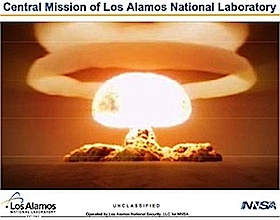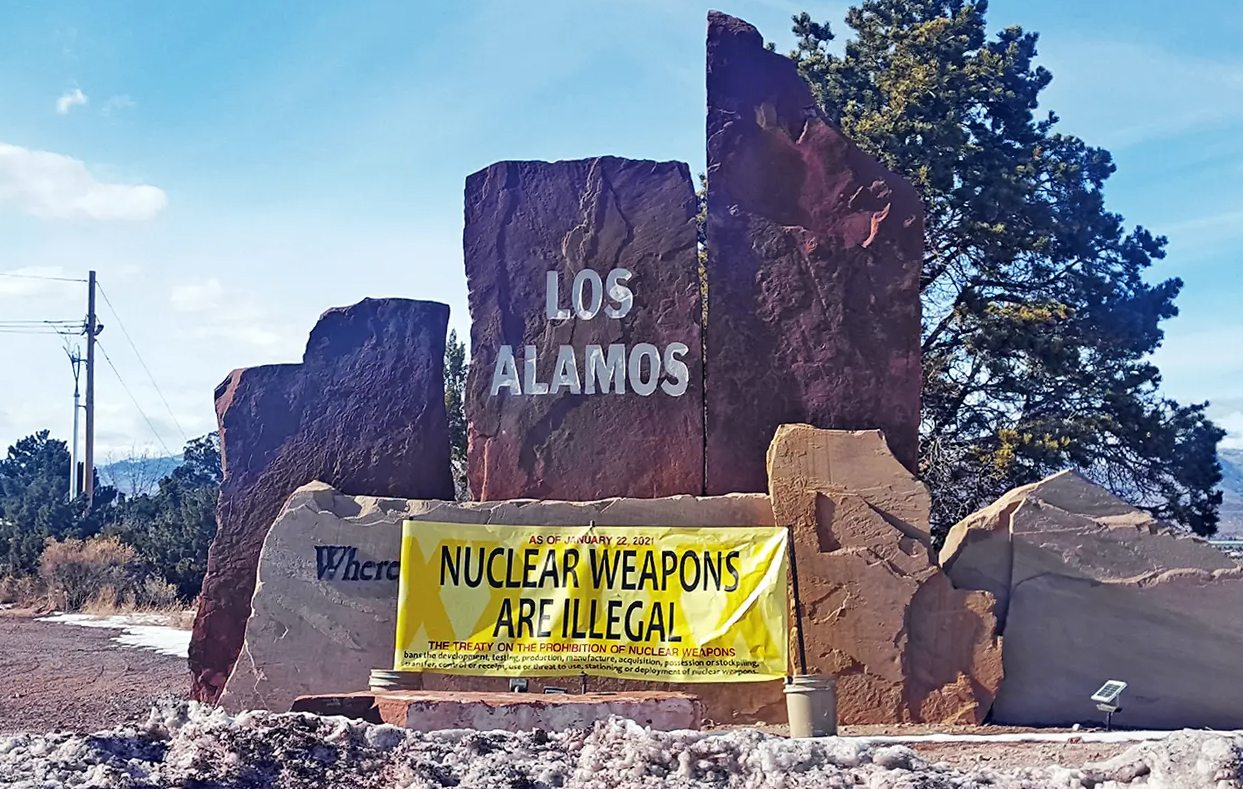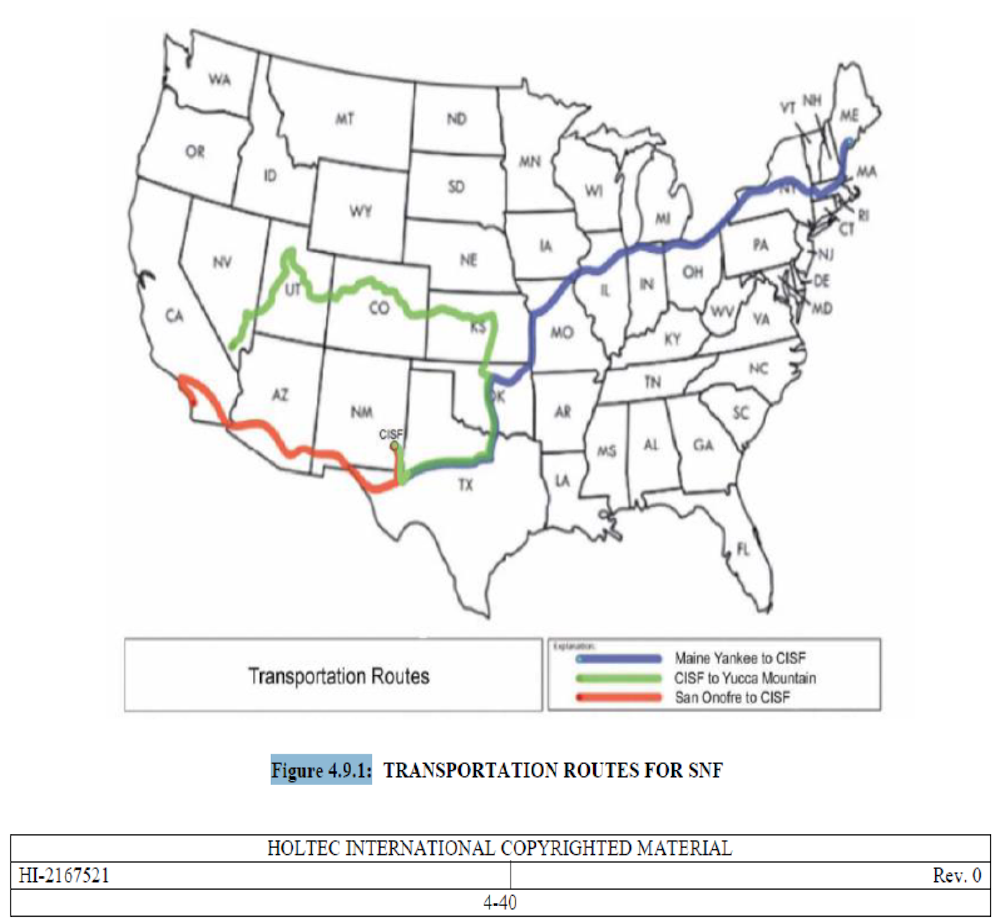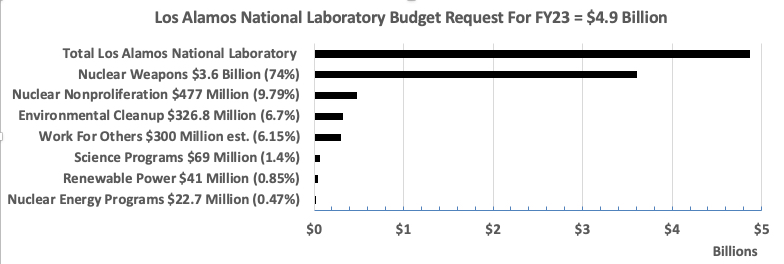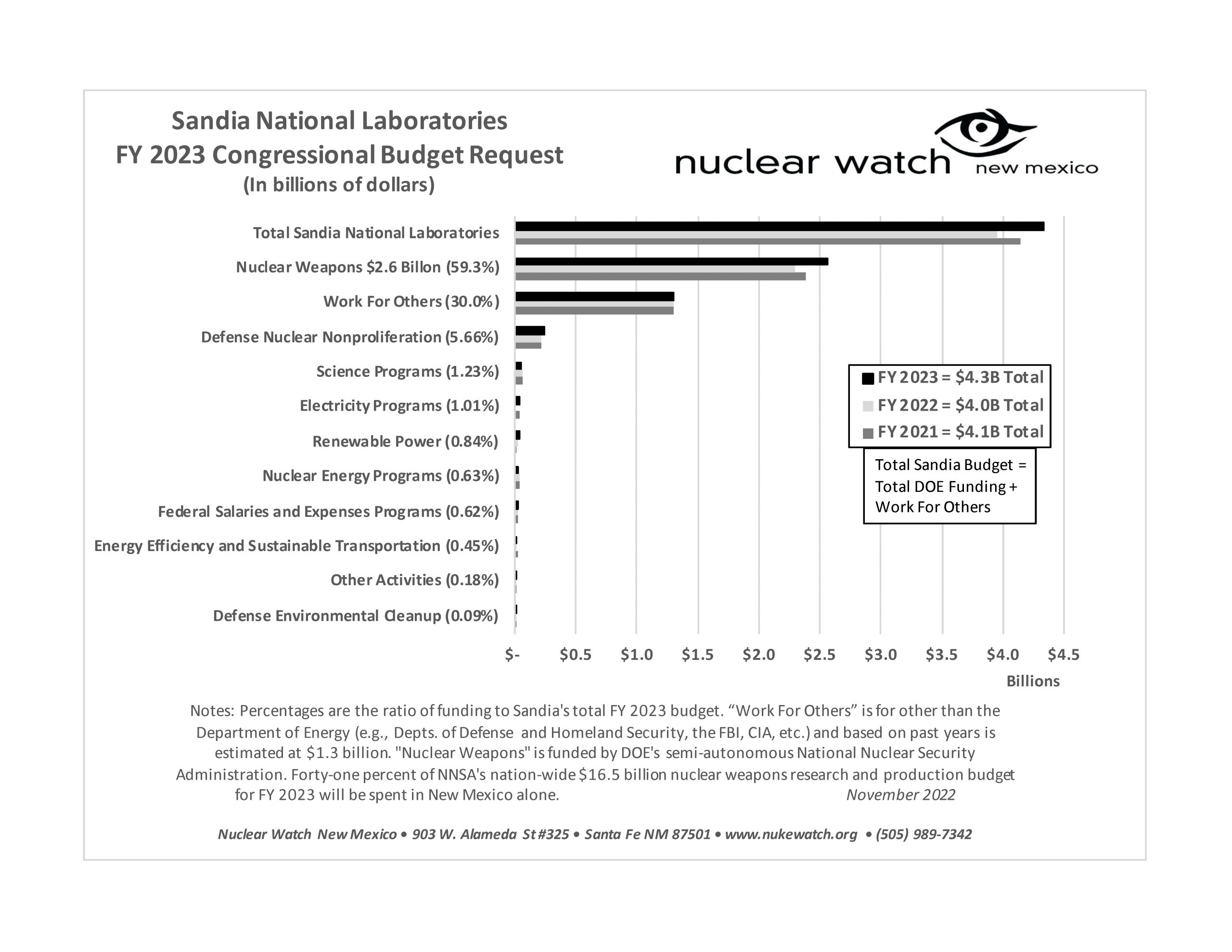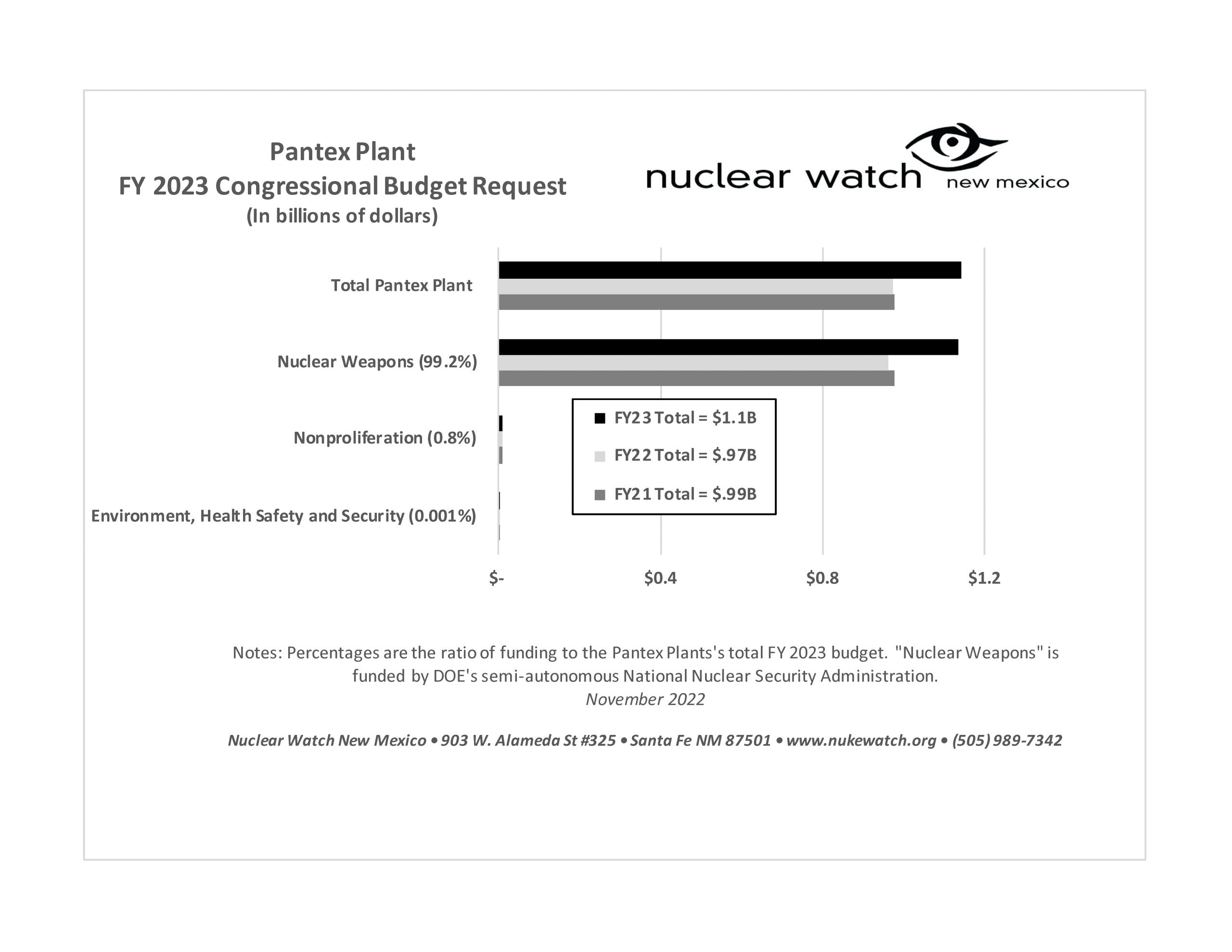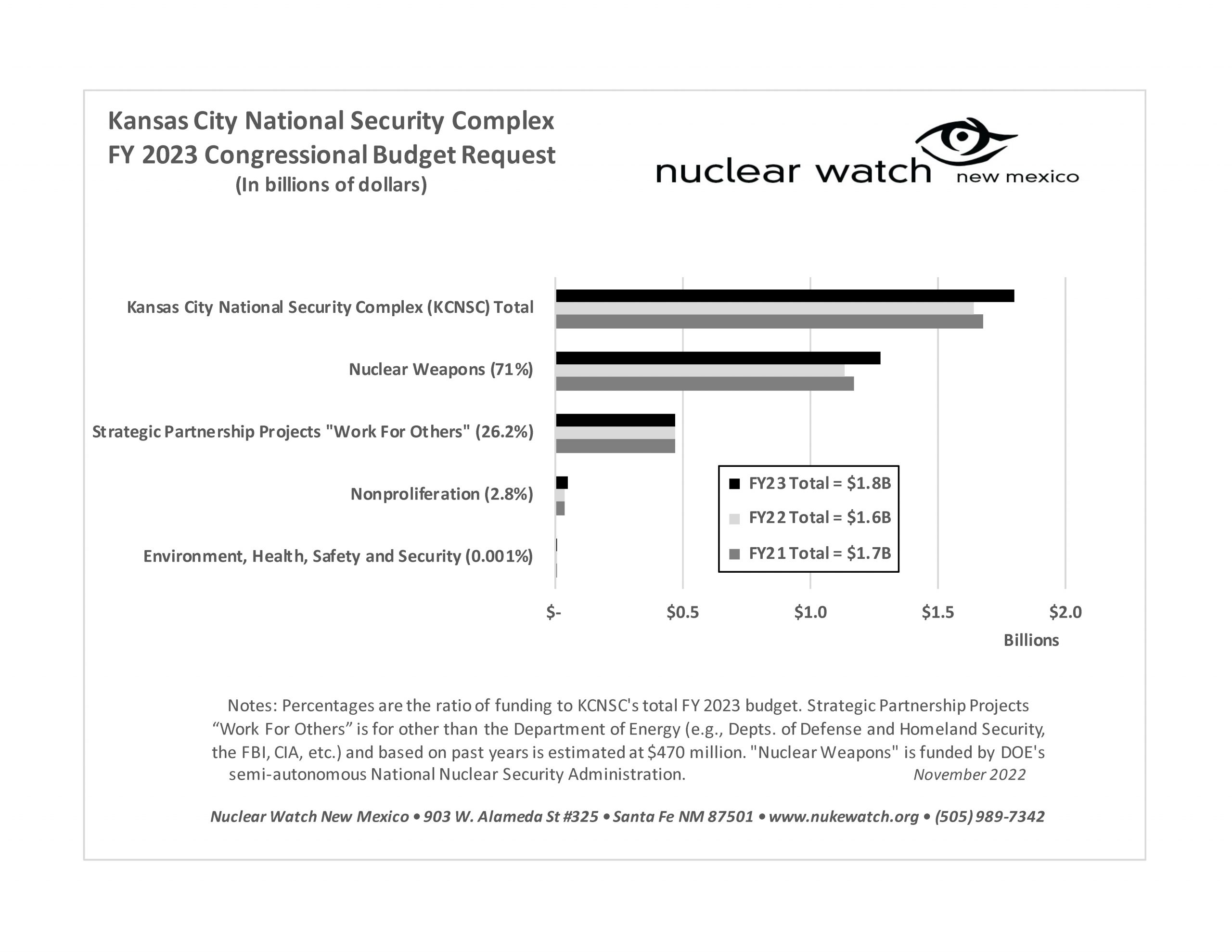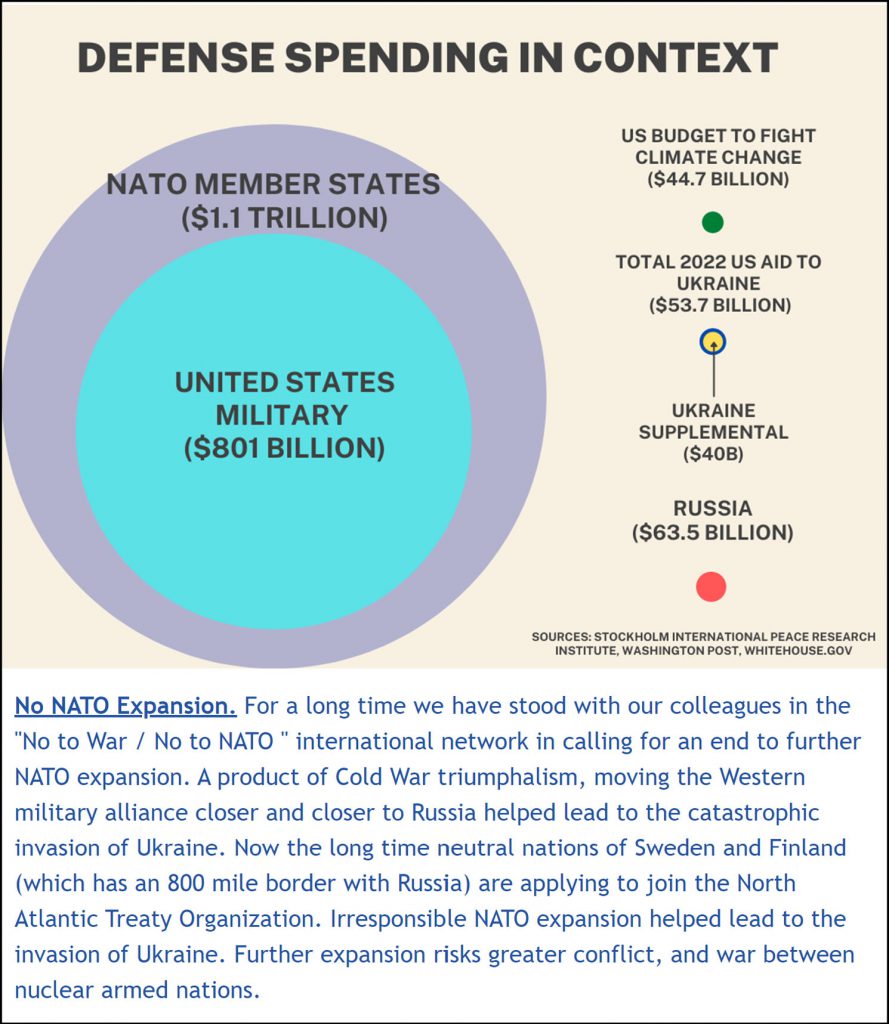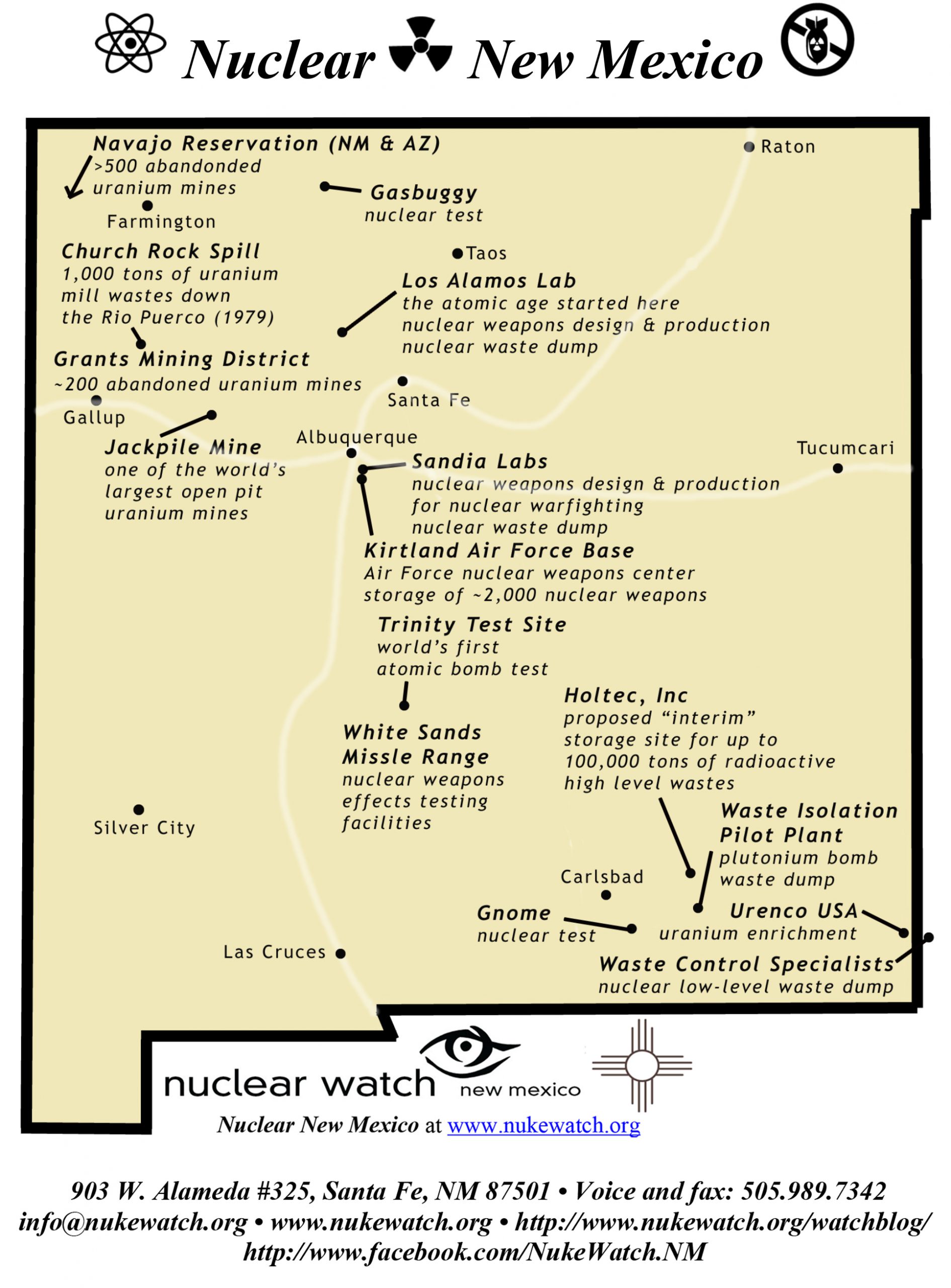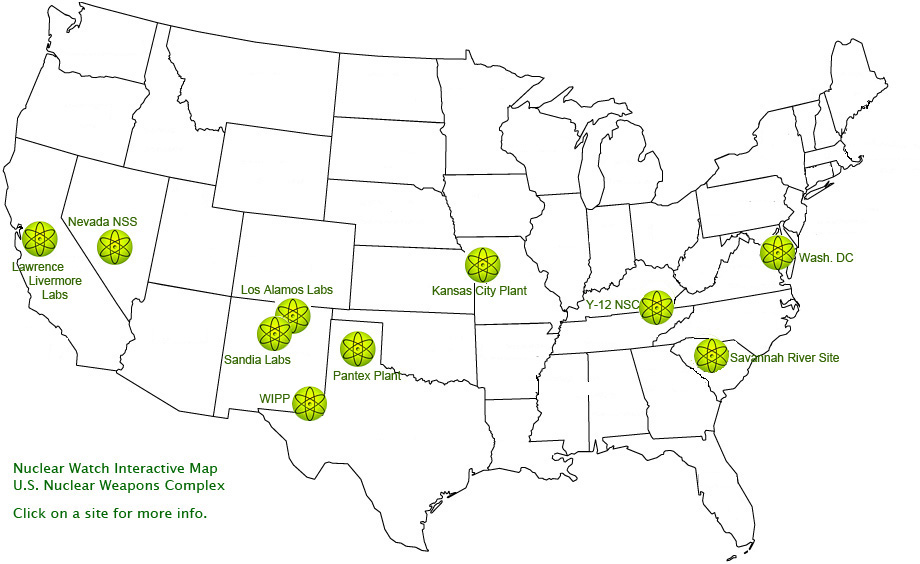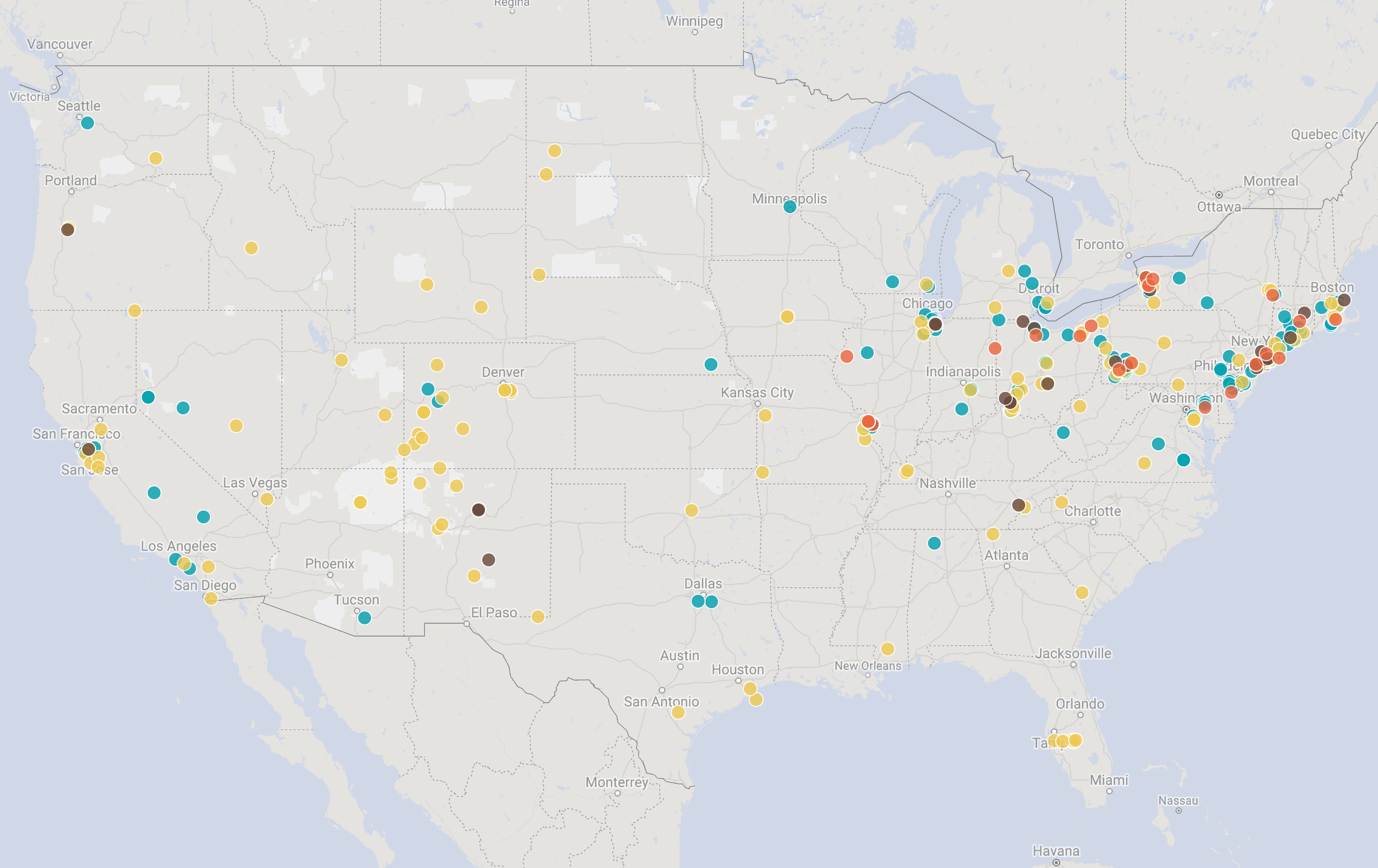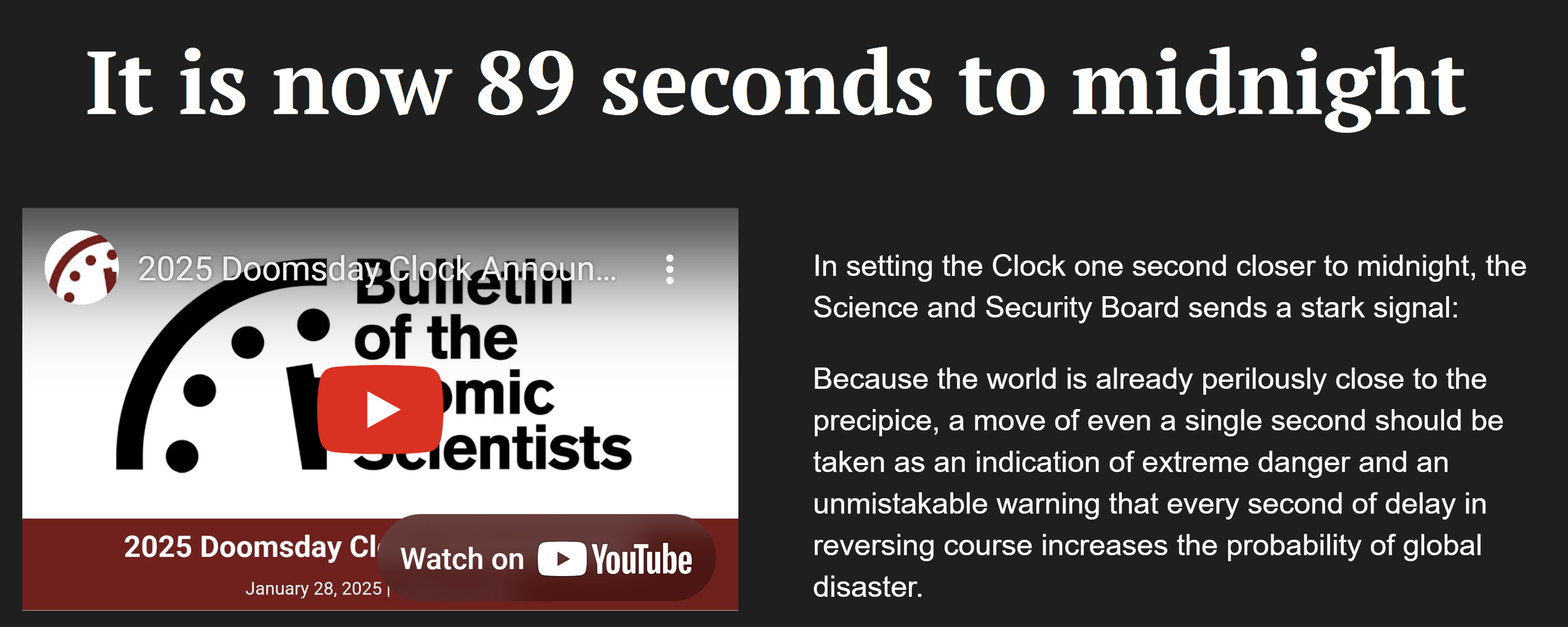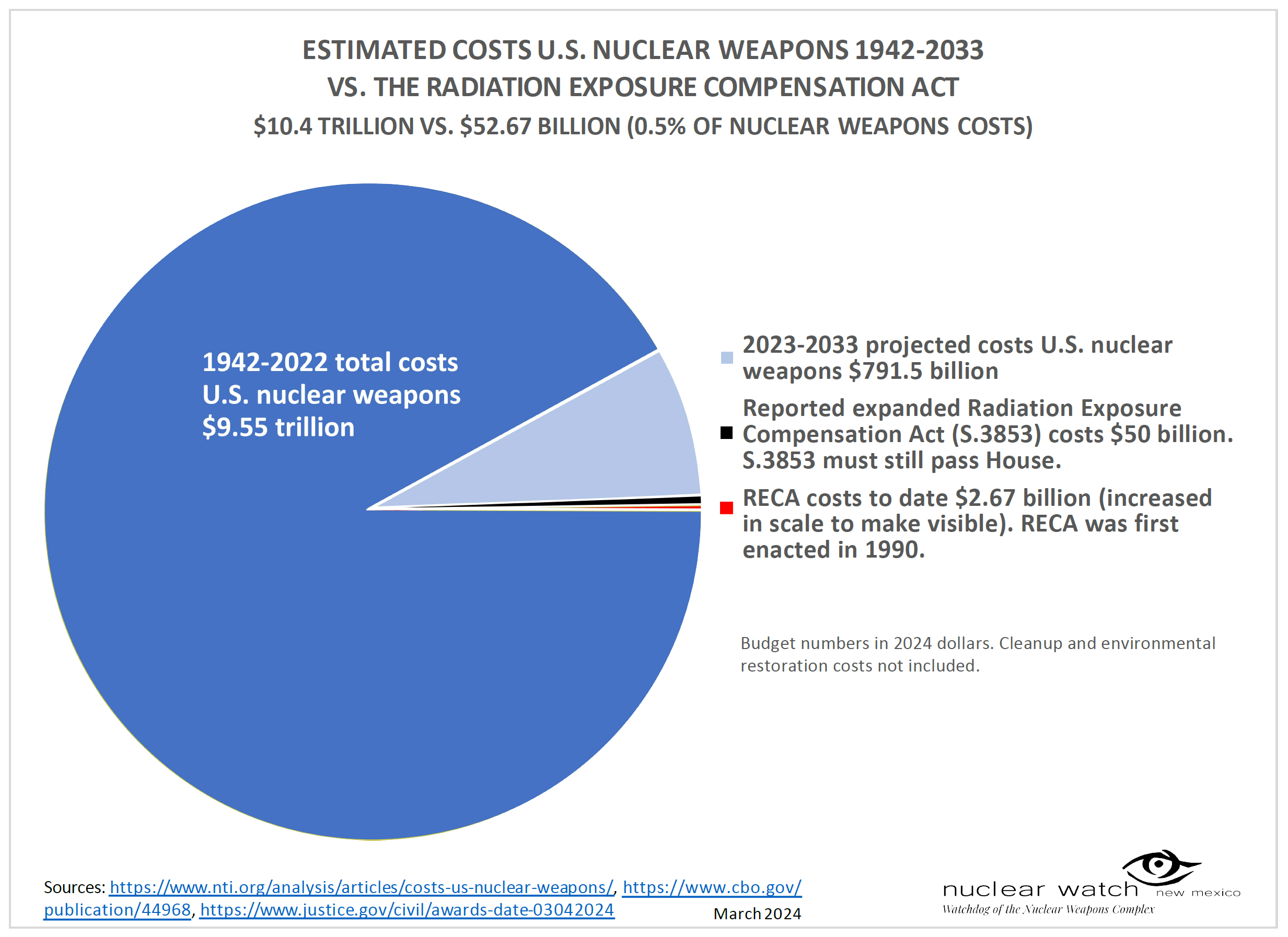QUOTE OF THE WEEK
Nothing Found
It seems we can’t find what you’re looking for. Perhaps searching can help.
LANL’s Central Mission: Los Alamos Lab officials have recently claimed that LANL has moved away from primarily nuclear weapons to “national security”, but what truly remains as the Labs central mission? Here’s the answer from one of its own documents:
LANL’s “Central Mission”- Presented at: RPI Nuclear Data 2011 Symposium for Criticality Safety and Reactor Applications (PDF) 4/27/11
Banner displaying “Nuclear Weapons Are Now Illegal” at the entrance in front of the Los Alamos National Lab to celebrate the Entry Into Force of the Nuclear Weapon Ban Treaty on January 22, 2021
Nothing Found
It seems we can’t find what you’re looking for. Perhaps searching can help.
Follow the Money!
Map of “Nuclear New Mexico”
Nuclear Watch Interactive Map – U.S. Nuclear Weapons Complex
In 1985, US President Ronald Reagan and and Russian President Mikhail Gorbachev declared that “a nuclear war cannot be won and must never be fought.”
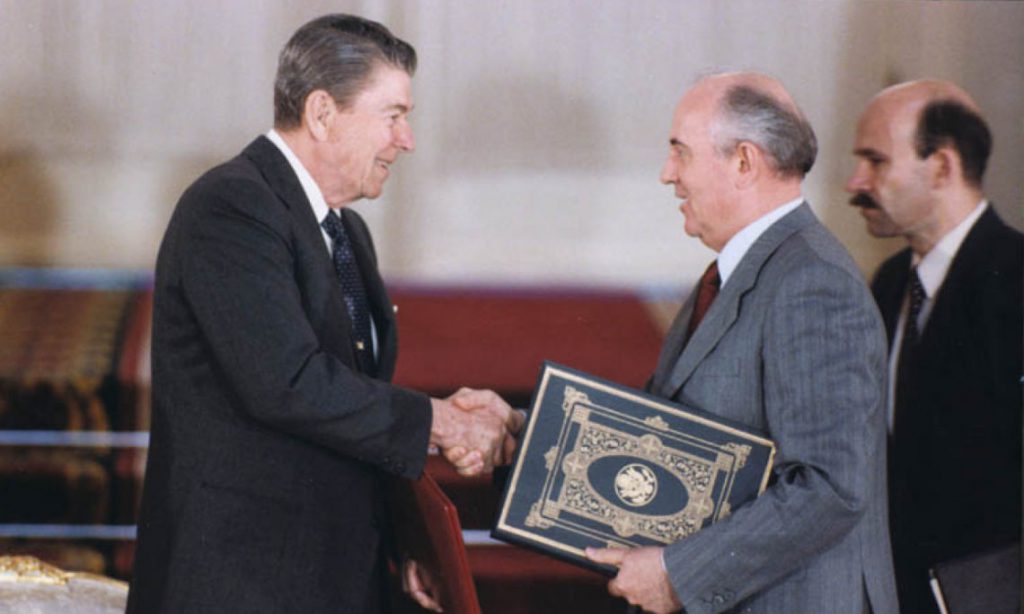
Waste Lands: America’s Forgotten Nuclear Legacy
The Wall St. Journal has compiled a searchable database of contaminated sites across the US. (view)
Related WSJ report: https://www.wsj.com
2022 BLOG POSTS
Nothing Found
It seems we can’t find what you’re looking for. Perhaps searching can help.
New & Updated
Los Alamos’ plutonium pit production of 30 annually for Sentinel may have to wait beyond 2026
As the Department of Energy’s National Nuclear Security Administration awaits its marching orders from the President Donald Trump (R) administration, the Los Alamos National Laboratory is now saying it will get to an annual plutonium pit production goal of 30 “ASAP.”
Exchange Monitor | January 31, 2025 counterpunch.com
Such pits are the triggers for thermonuclear weapons…
Step inside the secret lab where America tests its nukes
“”The risk is significant,” says Hans Kristensen, director of the Nuclear Information Project at the Federation of American Scientists. The talk of testing comes at a time when nuclear weapons are resurgent: Russia is designing nuclear weapons to attack satellites and obliterate seaports; China is dramatically expanding its nuclear arsenal; and the U.S. is undergoing a major modernization of its nuclear warheads. After years of declining nuclear stockpiles, the world looks poised to begin increasing the number and types of nuclear weapons being deployed.”
By Geoff Brumfiel, NPR | January 29, 2025 npr.org

A half-mile from here, on the morning of May 8, 1953, an Air Force bomber dropped a Mk-6D nuclear bomb from a height of 19,000 feet above the desert floor. It exploded with a yield of 27 kilotons of TNT — creating a shockwave that warped the bridge. The test, code-named “Encore,” was one of several conducted here to see what, if anything, in the civilian world could survive a nuclear blast (the answer is, apparently, not much).
Continue reading
Exchange Monitor: Compromise reached on pit production suit environmental review
“The National Nuclear Security Administration and environmental plaintiffs settled a lawsuit that could put a pause on plutonium pit production efforts at Savannah River Site if approved.”
By Exchange Monitor | January 29, 2025 exchangemonitor.com
The agreement, made public Jan. 16, would leave Los Alamos National Laboratory as the National Nuclear Security Administration’s (NNSA) sole pit factory until an environmental impact statement is completed as part of the National Environmental Protection Act (NEPA). The process is expected to take at least two-and-a-half years, according to the document.
Until a record of decision is issued from the environmental review, NNSA is enjoined from installing classified equipment or introducing nuclear material at the Savannah River plant, according to a press release from the citizen groups. Actual pit production at Savannah River is not expected before the 2030s, according to NNSA.
The plaintiffs alleged in the lawsuit from 2021 that NNSA and DOE would violate NEPA by producing plutonium pits at Los Alamos and Savannah River Site without conducting a proper environmental review. A federal judge agreed with the plaintiffs in September, but instigated months of back and forth between both parties by forcing them to agree to a solution themselves.
The settlement requires NNSA to produce a new programmatic environmental impact statement within two-and-a-half years. Until that is complete in a process that would include public hearings nationwide and public comment on the draft of the statement, NNSA would not be able to process nuclear material at Savannah River’s plutonium facility.
The plaintiffs in the suit include environmental watch group Savannah River Site Watch of South Carolina; Tom Clements, director of Savannah River Site Watch; The Gullah Geechee Sea Island Coalition, a group representing the interests of some descendants of enslaved Africans dwelling on the lower Atlantic coast; Nuclear Watch New Mexico of Santa Fe, N.M.; and the Tri-Valley Communities Against a Radioactive Environment, of Livermore, Calif.
Hot Plutonium Pit Bomb Redux
“Plaintiffs including Savannah River Site Watch, South Carolina Environmental Law Project Gullah/Geechee Sea Island Coalition, Nuclear Watch New Mexico and Tri-Valley CAREs forced NNSA to halt construction on many phases of its plutonium pit facility near Aiken, SC, to hold public scoping meetings, solicit public comments, and produce a Programmatic Environmental Impact Statement within thirty months.”
By Mark Muhich, Counterpunch | January 31, 2025 counterpunch.com

Last week U.S. District Judge Mary Lewis Geiger, South Carolina, faulted the Department of Energy and the National Nuclear Security Agency for ignoring the National Environmental Protection Act and rushing plans to fabricate plutonium pit bombs at Savannah River Site, near Aiken, South Carolina.
Newly designed plutonium pits will serve as “triggers” for the next generation of nuclear warheads mounted atop Sentinel, the next generation of intercontinental ballistic missile, and for new submarine-launched nuclear weapons. Combined, these projects comprise major components in the trillion-dollar “modernization” of the U.S. strategic deterrence force.
Continue reading
Lawmakers say no to storing nuclear waste in Wyoming
Distrust over the federal government’s ability to build a permanent repository played a critical role in committee’s decision to kill controversial ‘temporary’ storage bill.
In addition to being flooded with emails and phone calls from constituents opposed to warehousing the deadly, radioactive material, several lawmakers on the panel were not convinced that a “temporary” storage facility would, in fact, be temporary. They noted that the federal government has tried and failed for decades to establish a permanent nuclear waste repository that would give some legitimacy to the “temporary” storage concept.
By Dustin Bleizeffer, WyoFile | January 30, 2025 wyofile.com
Despite growing support for nuclear energy nationally and here in Wyoming, there are simply too many concerns to entertain the possibility of opening the state to the country’s growing stockpile of spent nuclear fuel waste, some lawmakers say.
House Bill 16, “Used nuclear fuel storage-amendments,” touted by its backers as a tool to initiate a larger conversation, died Wednesday morning in the House Minerals, Business and Economic Development Committee.
In addition to being flooded with emails and phone calls from constituents opposed to warehousing the deadly, radioactive material, several lawmakers on the panel were not convinced that a “temporary” storage facility would, in fact, be temporary. They noted that the federal government has tried and failed for decades to establish a permanent nuclear waste repository that would give some legitimacy to the “temporary” storage concept.
Related:
Doomsday Clock: It is now 89 seconds to midnight
Bulletin of the Atomic Scientists | January 28, 2025 thebulletin.com
In 2024, humanity edged ever closer to catastrophe. Trends that have deeply concerned the Science and Security Board continued, and despite unmistakable signs of danger, national leaders and their societies have failed to do what is needed to change course. Consequently, we now move the Doomsday Clock from 90 seconds to 89 seconds to midnight—the closest it has ever been to catastrophe. Our fervent hope is that leaders will recognize the world’s existential predicament and take bold action to reduce the threats posed by nuclear weapons, climate change, and the potential misuse of biological science and a variety of emerging technologies.
In setting the Clock one second closer to midnight, we send a stark signal: Because the world is already perilously close to the precipice, a move of even a single second should be taken as an indication of extreme danger and an unmistakable warning that every second of delay in reversing course increases the probability of global disaster.
In regard to nuclear risk, the war in Ukraine, now in its third year, looms over the world; the conflict could become nuclear at any moment because of a rash decision or through accident or miscalculation. Conflict in the Middle East threatens to spiral out of control into a wider war without warning. The countries that possess nuclear weapons are increasing the size and role of their arsenals, investing hundreds of billions of dollars in weapons that can destroy civilization. The nuclear arms control process is collapsing, and high-level contacts among nuclear powers are totally inadequate given the danger at hand. Alarmingly, it is no longer unusual for countries without nuclear weapons to consider developing arsenals of their own—actions that would undermine longstanding nonproliferation efforts and increase the ways in which nuclear war could start.
U.S. Senators Luján, Hawley, Heinrich, Schmitt, Reintroduce RECA To Give Nuclear Radiation Victims Compensation

By Carol A. Clark, Los Alamos Daily Post | January 24, 2025 ladailypost.com
Despite the Senate passing this bill, the House of Representatives failed to pass the Radiation Exposure Compensation Act (RECA) reauthorization before its expiration deadline in the 118th Congress.
“In New Mexico and across the country, thousands sacrificed to contribute to our national security. Today, individuals affected by nuclear weapons testing, downwind radiation exposure, and uranium mining are still waiting to receive the justice they are owed,” Sen. Luján said.
“It is unacceptable that so many who have gotten sick from radiation exposure have been denied compensation by Congress. Despite having passed RECA legislation twice through the Senate with broad bipartisan support, and securing the support of the previous administration, I was disheartened that Speaker Johnson refused a vote on RECA to help victims. This Congress, I am proud to partner with Senator Hawley again to extend and expand RECA. RECA is a bipartisan priority and I am hopeful that we will once again get it through the Senate and hope the Speaker commits to getting victims the compensation they are owed.”
Trump wants nuclear reduction talks with China, Russia
Trump recounted talks with Putin ahead of the 2020 U.S. election about denuclearization talks and how “China would have come along.”
“We want to see if we can denuclearize, and I think that’s very possible,” Trump said.
By Laura Kelly, The Hill | January 23, 2025 thehill.com
President Trump while addressing the World Economic Forum in Davos on Thursday said that he wants to hold talks with Russia and China about reducing nuclear weapon stockpiles.
Trump during his first term failed to bring China into negotiations to extend a nuclear arms treaty with Russia, called New START, which places key limits on deployed nuclear weapons and expires February 2026.
U.S. and Russian participation in the treaty effectively froze during the Biden administration, as Russian President Vladimir Putin sought to impose costs on Washington for supporting Ukraine militarily.
Remember the Downwinders
Today, Jan. 27 is a National Day of Remembrance for Downwinders. Nuclear testing by the U.S. government started in New Mexico with the Trinity Test in July 1945, and the Crossroads Series of three tests followed in the Pacific in 1946. The United States took part in nuclear testing as part of the escalating Cold War arms race, and nuclear weapons proliferated. Americans working and living downwind from nuclear testing sites became sick and killed by the radiation exposure generated from the aboveground atomic tests in Nevada, which began on January 27, 1951 and ended on July 17, 1962. With each nuclear test, radioactive fallout spread globally. Of course, downwinders are not only American. At the so-called “Pacific Proving Grounds” in the Marshall Islands, 67 nuclear weapons were detonated between 1945 and 1962.
From GUAM PACIFIC DAILY NEWS 1/27/25:
“It became a site of unimaginable destruction that did not stop at the blast zones. The radioactive fallout spread across the Pacific, settling on many islands like ours.” — Guam Senator Therese Terlaje
Seven of the top 10 adult cancers on Guam are now recognized as compensable for radiation exposure by the federal government, the senator noted.
Honoring Black Leaders in Disarmament
Russia Nuclear Update a project based at the MIT Security Studies Program that produces fact-based visual content on the threats posed by nuclear weapons, has shared a fantastic set of content that highlights the vital role that Black leaders have played in arms control and nuclear disarmament in celebration of Martin Luther King Jr. Day and Black History Month.
“50 Faces of Black Leaders” honors the many contributions of civil rights and other leaders who opposed nuclear war. This video content is provided in vertical and horizontal formats and is free of charge.
Russia Nuclear Update (MIT) | January 17, 2025 russianuclearupdate.org
The individuals featured in this series include both contemporary figures like Ambassador Bonnie Jenkins, and past generations, including Coretta Scott King, Bayard Rustin, and iconic artists.
Historic Settlement Reached in NEPA Lawsuit Over Plutonium “Pit” Bomb Core Production
Nonprofit public interest groups have reached an historic settlement agreement with the Department of Energy’s semi-autonomous nuclear weapons agency, the National Nuclear Security Administration (NNSA). This is the successful result of a lawsuit against NNSA over its failure to complete a programmatic environmental impact statement on the expanded production of plutonium “pit” bomb cores, as required by the National Environmental Policy Act (NEPA). This agreement and a joint motion to dismiss have been submitted to Judge Mary Lewis Geiger of the Federal District of South Carolina. Should the Court enter the dismissal and retain jurisdiction to enforce the settlement, the agreement will go into effect.
This lawsuit was first filed in June 2021 by co-plaintiffs Savannah River Site Watch of Columbia, SC; Nuclear Watch New Mexico of Santa Fe, NM; Tri-Valley Communities Against a Radioactive Environment (CAREs), based in Livermore, CA; and the Gullah/Geechee Sea Island Coalition of coastal Georgia. NNSA promptly moved to have the case dismissed which in February 2023 Judge Lewis rejected, calling her decision “not a close call.”
In September 2024, Judge Lewis ruled that DOE and NNSA had violated NEPA by failing to properly consider alternatives before proceeding with their plan to produce plutonium pits, a critical component of nuclear weapons, at the Los Alamos National Laboratory (LANL) in New Mexico and, for the first time ever, at the Savannah River Site (SRS) in South Carolina. The Court found that the plan’s purpose had fundamentally changed from NNSA’s earlier analyses which had not considered simultaneous pit production at two sites. Judge Lewis directed the Defendants and Plaintiffs to prepare a joint proposal for an appropriate remedy which fostered additional negotiations.
Historic Settlement Reached in NEPA Lawsuit Over Plutonium “Pit” Bomb Core Production
FOR IMMEDIATE RELEASE, January 17, 2025
Media Contacts:
Ben Cunningham, Esquire, SCELP, 843-527-0078, ben@scelp.org
Tom Clements, Savannah River Site Watch, 803-834-3084, tomclements329@cs.com
Jay Coghlan, Nuclear Watch New Mexico, 505-989-7342, jay@nukewatch.org
Scott Yundt, Tri-Valley CAREs, 925-443-7148, scott@trivalleycares.org
Queen Quet, Gullah/Geechee Sea Island Coalition, 843-838-1171, GullGeeCo@aol.com
AIKEN, S.C. — Nonprofit public interest groups have reached an historic settlement agreement with the Department of Energy’s semi-autonomous nuclear weapons agency, the National Nuclear Security Administration (NNSA). This is the successful result of a lawsuit against NNSA over its failure to complete a programmatic environmental impact statement on the expanded production of plutonium “pit” bomb cores, as required by the National Environmental Policy Act (NEPA). This agreement and a joint motion to dismiss have been submitted to Judge Mary Lewis Geiger of the Federal District of South Carolina. Should the Court enter the dismissal and retain jurisdiction to enforce the settlement, the agreement will go into effect.
This lawsuit was first filed in June 2021 by co-plaintiffs Savannah River Site Watch of Columbia, SC; Nuclear Watch New Mexico of Santa Fe, NM; Tri-Valley Communities Against a Radioactive Environment (CAREs), based in Livermore, CA; and the Gullah/Geechee Sea Island Coalition of coastal Georgia. NNSA promptly moved to have the case dismissed which in February 2023 Judge Lewis rejected, calling her decision “not a close call.”
In September 2024, Judge Lewis ruled that DOE and NNSA had violated NEPA by failing to properly consider alternatives before proceeding with their plan to produce plutonium pits, a critical component of nuclear weapons, at the Los Alamos National Laboratory (LANL) in New Mexico and, for the first time ever, at the Savannah River Site (SRS) in South Carolina. The Court found that the plan’s purpose had fundamentally changed from NNSA’s earlier analyses which had not considered simultaneous pit production at two sites. Judge Lewis directed the Defendants and Plaintiffs to prepare a joint proposal for an appropriate remedy which fostered additional negotiations.
Anti-nuclear advocates, feds, compromise on pit production lawsuit
“We’re generally satisfied [with the terms],” said Nuclear Watch New Mexico executive director Jay Coghlan.
But what about the other half of the two-site plan?
“The fish that got away is Los Alamos,” Coghlan said.
Alaina Mencinger | January 17, 2025 santafenewmexican.com
The National Nuclear Security Administration and anti-nuclear advocates have reached agreement in a lawsuit over the National Environmental Protection Act that could temporarily halt plutonium pit production efforts at the Savannah River Site in South Carolina.
If approved, the proposed agreement, reached Thursday, would leave Los Alamos National Laboratory as the agency’s only pit production site until a far-reaching environmental impact statement can be completed, which is expected to take at least 2½ years.
Nuclear Watch New Mexico and other groups around the country alleged in a 2021 lawsuit the federal government had violated the National Environmental Protection Act in the course of deciding to produce plutonium pits, the trigger device for nuclear weapons, at both Los Alamos National Laboratory and the Savannah River Site.
DOE Rejects Comprehensive Cleanup at Los Alamos Lab; Designates Expanded Nuclear Weapons Production as Preferred Future
FOR IMMEDIATE RELEASE, January 15, 2025
Contact: Jay Coghlan, 505.989.7342 | Email
Santa Fe, NM – Today, in an informal conference hosted by the New Mexico Environment Department (NMED), the Department of Energy rejected future excavation, characterization and further treatment of its radioactive and toxic wastes at the Los Alamos National Laboratory. Just five days ago, DOE’s National Nuclear Security Administration formally designated radically expanded nuclear weapons programs as the “preferred alternative” for the Lab’s future.[1] The key issue is the expanded production of plutonium “pit” bomb cores for the accelerating nuclear arms race.
In a draft Order, NMED directed DOE to comprehensively clean up “Area C,” a radioactive and toxic waste dump from the 1950s. Nuclear Watch New Mexico strongly supports NMED’s position. Area C is relatively small and shallow at 11 acres and not more than 25 feet deep. Therefore, it is an excellent model for future comprehensive cleanup at LANL, such as the much larger Area G waste dump. A public hearing is required before NMED can implement a final Order, but DOE seeks to delay that hearing as well.
ACTION ALERTS
Nothing Found
It seems we can’t find what you’re looking for. Perhaps searching can help.
Nothing Found
It seems we can’t find what you’re looking for. Perhaps searching can help.
Interfaith Panel Discussion on Nuclear Disarmament - August 9
Nothing Found
It seems we can’t find what you’re looking for. Perhaps searching can help.
New Nuclear Media
Nothing Found
It seems we can’t find what you’re looking for. Perhaps searching can help.

